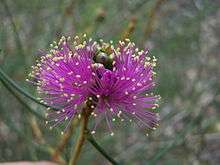Melaleuca nematophylla
Melaleuca nematophylla, commonly known as wiry honey-myrtle is a plant in the myrtle family, Myrtaceae and is endemic to the south-west of Western Australia. It is one of the showiest melaleucas when in flower in early spring, is easily grown and has unusual needle-like foliage. As a result, it is relatively common in cultivation in temperate parts of Australia.
| Wiry honey-myrtle | |
|---|---|
 | |
| M. nematophylla flowers | |
| Scientific classification | |
| Kingdom: | Plantae |
| Clade: | Tracheophytes |
| Clade: | Angiosperms |
| Clade: | Eudicots |
| Clade: | Rosids |
| Order: | Myrtales |
| Family: | Myrtaceae |
| Genus: | Melaleuca |
| Species: | M. lutea |
| Binomial name | |
| Melaleuca lutea | |
Description
Melaleuca nematophylla is an erect, rounded shrub with coarse, brownish, papery bark and which grows to a height of about 3 m (10 ft). Its leaves and branches are glabrous. The leaves are 40–160 mm (2–6 in) long, 0.7–1.5 mm (0.03–0.06 in) wide, circular in cross section and taper to a sharp but not prickly point.[1][2]
The flowers are a shade of pink to purple and are arranged in heads on the ends of most of the branches, which continue to grow after flowering. The heads are up to 55 mm (2 in) in diameter but more usually about half that size, and contain 10 to 20 groups of flowers in threes. The stamens are in five bundles around the flower, each bundle with 7 to 13 stamens. Flowering usually occurs in September or October and the fruit which follow are woody capsules 3–6 mm (0.1–0.2 in) long in roughly spherical clusters along the stems.[1][2]
Taxonomy and naming
Melaleuca nematophylla was first formally described in 1862 by Ferdinand von Mueller in Fragmenta Phytographiae Australiae[3] but the publication was not valid.[4] The name was validated by Lyndley Craven in 1999.[5][6] The specific epithet (nematophylla) is from the Ancient Greek nêma meaning "thread"[7]:798 and phýllon meaning “leaf”[7]:466 in reference to the thread-like leaves of this species.[1]
Distribution and habitat
This melaleuca occurs in and between the Kalbarri, Mullewa, Three Springs, Perenjori and Manning Range districts[1] in the Avon Wheatbelt, Coolgardie, Geraldton Sandplains, Murchison and Yalgoo biogeographic regions.[8] It grows in a range of soils on ridges and sandstone hilltops.[9]
Conservation
Melaleuca nematophylla is listed as "not threatened" by the Government of Western Australia Department of Parks and Wildlife.[8]
Use in horticulure
Wiry honey-myrtle is well known in cultivation in temperate parts of Australia and is suited to well drained soils in a sunny position, protected from severe frosts.[10]
References
- Brophy, Joseph J.; Craven, Lyndley A.; Doran, John C. (2013). Melaleucas : their botany, essential oils and uses. Canberra: Australian Centre for International Agricultural Research. p. 248. ISBN 9781922137517.
- Holliday, Ivan (2004). Melaleucas : a field and garden guide (2nd ed.). Frenchs Forest, N.S.W.: Reed New Holland Publishers. pp. 194–195. ISBN 1876334983.
- von Mueller, Ferdinand (1862). Fragmenta Phytographiae Australiae. Melbourne. p. 119. Retrieved 4 June 2015.
- "Melaleuca nematophylla F.Muell.nom. inval". APNI. Retrieved 4 June 2015.
- "Melaleuca nematophylla F.Muell. ex Craven". APNI. Retrieved 4 June 2015.
- Craven, L. A.; Lepschi, B. J. (1999). "Enumeration of the species and infraspecific taxa of Melaleuca (Myrtaceae) occurring in Australia and Tasmania". Australian Systematic Botany. 12 (6): 888. doi:10.1071/SB98019.
- Brown, Roland Wilbur (1956). The Composition of Scientific Words. Washington, D.C.: Smithsonian Institution Press.
- "Melaleuca nematophylla". FloraBase. Western Australian Government Department of Parks and Wildlife.
- Paczkowska, Grazyna; Chapman, Alex R. (2000). The Western Australian flora : a descriptive catalogue. Perth: Wildflower Society of Western Australia. p. 395. ISBN 0646402439.
- Wrigley, John W.; Fagg, Murray (1983). Australian native plants : a manual for their propagation, cultivation and use in landscaping (2 ed.). Sydney: Collins. p. 266. ISBN 0002165759.